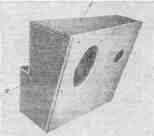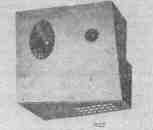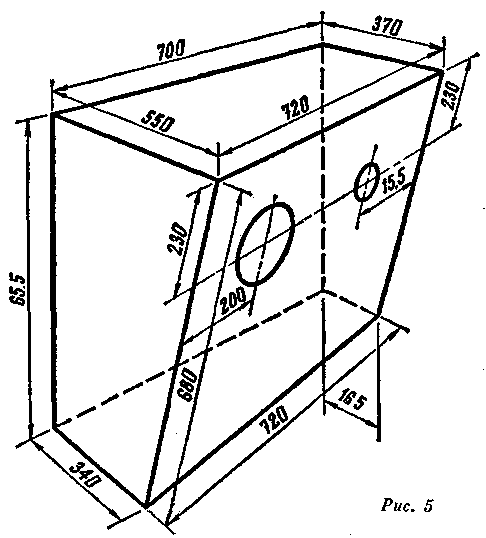Stereo system must reproduce each channel a wide range of sound frequencies with a minimum frequency and nonlinear distortions. An important condition is the choice of loudspeakers and acoustical design. If you have good acoustic units high-quality audio equipment can be obtained even when using a relatively simple bass amplifiers.
The sound quality is largely determined by the shape of the frequency characteristics of the acoustic units at lower audio frequencies.
When smooth frequency response of the acoustic unit, when the irregularity are "fuzzy" in nature and do not have a great height, the sound is soft, "not Intrusive" nature, as well heard all the tools of the bass. Thus, the obtaining of a smooth frequency response in the lower frequencies is crucial for high quality sound reproduction.
For a stereo system it is desirable to select a pair of identical speakers. If there is a ham radio operator has a low frequency loudspeakers having a frequency of mechanical resonance of the moving system below 45 Hz, then a couple with each of them you need to enable high-frequency loudspeaker ("Squeaker"). In the case of broadband loudspeakers, for example HD-28 or HD-4 using high frequency link is optional, but is always preferable to have a separate play lower and higher frequencies to reduce intermodulation distortion. In this case it is necessary to apply a separation filter that excludes the supply of low-frequency components of the signal to the tweeter.
Design of acoustic units with a closed rear wall can be given the following recommendations. Wall and a front Board should be made of thick (not less than 15-20 mm} of plywood or chipboard. Low-frequency or broadband loudspeaker should be set asymmetrically in relation to the axes of symmetry of the box. An irregular shape of the box (non-parallelism of the walls) should be recognized as preferable to rectangular or any other symmetrical shape. When performing these measures reduced frequency response the unit in the lower frequencies (in the field of higher and medium frequencies this is achieved by the selection of speakers).
It is advisable to place the acoustic units stereos, made in the form of boxes with closed rear wall in the upper corners of the room. (In the case of a long room on the lower wall). Since the speakers in this case be located significantly above seated listener, front Board units should be tilted down and turned through the same angle inwards.
The author has been fabricated and tested two (left and right) corner of the acoustic Assembly. Their volume is 135 dm3. The appearance of one of them is shown in Fig.1 and Fig.2. The ledge on the back wall due to the presence of the rafters at the place of installation of the units. In this design were tested loudspeakers HD-28 and HD-1. As the speaker HD-28 is more common, then the measurements were carried out in a larger volume.


Fig. 1 - 2
In Fig.3 shows frequency characteristics of the loudspeaker GD-28 when you install it in a corner unit (solid line) and in a rectangular box of the same volume (dotted line). Both empty box. All frequency characteristics were measured under conditions equivalent to the free space.

Fig.3
The comparison shows that the peak height for corner unit below 3 dB. When listening, but the sound character of the lower frequencies was judged to be unsatisfactory. Then in a lower side wall of the unit was installed panel acoustic resistance PAZ (see "Radio" No. 4, 1969, pp. 27-28). The hole diameter panel is 30 mm, the number of loudspeaker HD-28 was 9 PCs., and for HD-1-21 units of the Damping cloth served as linen. To improve the transient characteristics in the midrange, the flip side of the loudspeaker is covered by a layer of glass wool. Then, in the same unit was installed loudspeaker GD-1 with high frequency loudspeaker HD-15, covered inside a tight lid. In Fig.4 shows the frequency response of these two speakers with a PASS and wool.

Fig.4
When listening to the sound of angular aggregates with a PASS and wool was found to be most enjoyable. Especially sounded good units with loudspeaker GD-1 and "Squeaker".
To produce acoustic corner unit virtually no more complicated than a simple box with a closed rear wall. From the point of view of finishes (gluing veneer, polishing) corner unit has the advantage over conventional mailbox because in addition to the rear does not need to be finished and two side walls (Fig. 1 wall "a" and "b"). Constructive drawing of the left unit and its dimensions are shown in Fig. 5. The right unit must have a slope of front Board to the other side, mirroring the left. Cut from plywood or chipboard details of the boxes are fastened together tightly, without gaps, with rods, glue and screws. Front Board is removable and is screwed to the box with screws and metal brackets with threaded mounted on the side walls. For a more snug fit between the front Board and the drawer placed a strip of felt. Of course, when you build the box instead of the front boards are removable, you can make the back cover.

Fig.5
The back side of the speaker to wrap the wool can be read. First, you need to take a piece of any fabric and cover it flip side is already installed on the front Board of a speaker. The fabric keeps the wool on the loudspeaker and protects her from the diffuser. Then cardboard cut strip width of 30-40 m h such that, being laid on the front Board near the speaker, it fits close to DiffuseMaterial. In case of a circular loudspeaker stripe must be in the form of a circle, in the case of an elliptical - elliptical. Cut a strip of cardboard is then placed on top of the fabric close to the loudspeaker and nailed to a Board small nails along with tight on the speaker cloth. After that, the loudspeaker on and around the strip of cardboard uniform layer stack cotton or tow and the protruding ends of fabric tied in a knot above the magnetic system. Of course, the size of the piece of cloth should be sufficient.
The exterior of each unit radio Amateur can produce according to your taste and possibilities. Color decorative fabric covering the front Board outside, you should pick up the tone with the colour of the upholstery or Wallpaper.
Author: Ing. V. Environment And Experiments; Publication: N. Bolshakov, rf.atnn.ru






